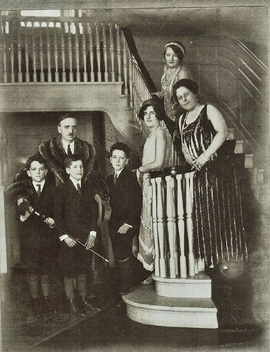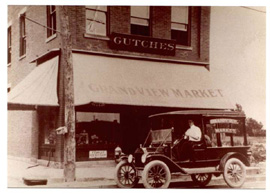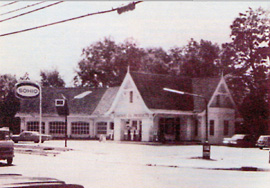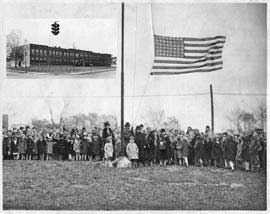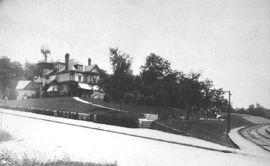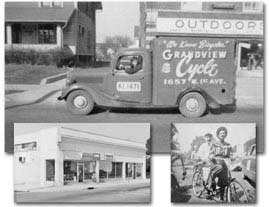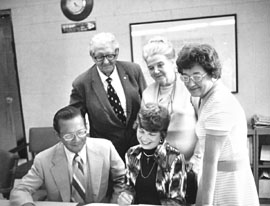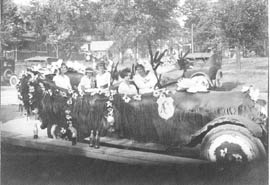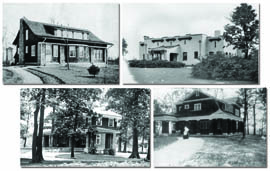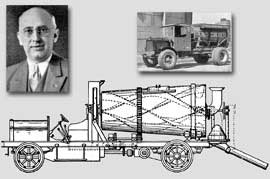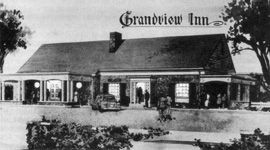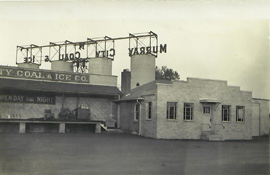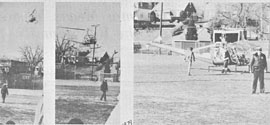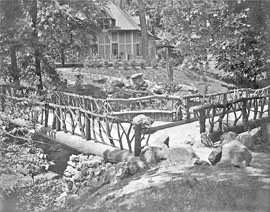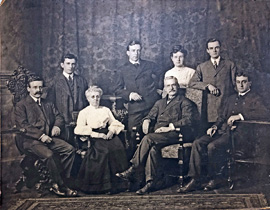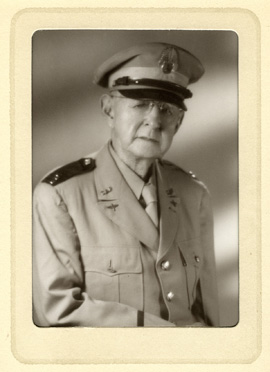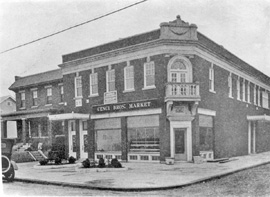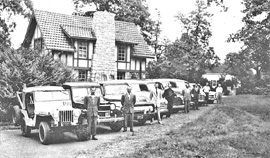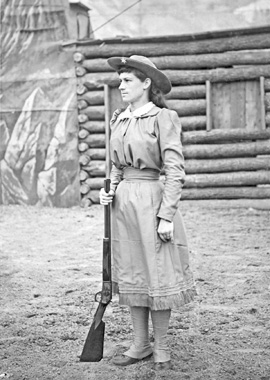| |
 |
| |
Adrian Wallick Family |
|
Adrian Lafayette ("Doc") and Marybelle Currie Wallick are shown here at the main staircase in the Wallick mansion on Roxbury Road, with their children in this 1922 photo from the Wallick family archives. The children are, left to right: twins Louis and Currie, Adrian Jr., Mary Belle, and Nancianna. The mansion was built around 1910 by influential Marble Cliff resident and Columbus businessman Butler Sheldon. It was purchased in 1917 by Doc Wallick, who with his brother Lou was the owner of the Deshler Hotel at Broad and High in downtown Columbus and the Secor Hotel in Toledo. Doc Wallick was educated as a dentist in Chicago and practiced in Louisiana. He made his money as a successful businessman, serving as the Vice President and General Manager of the hotels for his wealthy brother, who lived in New Jersey. His son, Adrian Jr. was later the proprietor of A. L. Wallick Refractories on Johnstown Road on the east side of the city. Wallick called his home Shalimar. |
|
| |
Gutches Grandview Market |
|
Gutches Grandview Market was one of many neighborhood grocery stores located around Grandview Heights and Marble Cliff. It was located at the corner of First Avenue and Oakland in the former Celeste Realty building, which was razed to build condominiums. The building later housed Gaudieri's Cleaners and Tailor Shop, and for a short time housed the Grandview Public Library. This early photo shows Mr. Gutches in his delivery car, and a sign in the window advertising Furnas Ice Cream. The Furnas Ice Cream Co. was started in Indiana, and later partnered with Velvet and the Borden Co.
|
|
| |
Sohio Station |
|
The Standard Oil Company Ohio purchased the lot at the southeast corner of Fifth Avenue and Cambridge Blvd in Marble Cliff in the early 1920s. They constructed this innovative station in the Tudor architectural style in 1926. for nearly fifty years, the company operated the repair shop and gasoline station to serve the tri-village area. The design of the building, with the multiple repair bays and drive-thru pumping bay, was a major variation from the traditionally smaller stations that existed before the emergence of Standard Oil as a dominant player in the gas and oil retail industry to serve the expanding automobile as a transportation mode. In 1975 the station closed and the building was purchased by C-G Realty and renovated as a commercial office and retail space. In 1985 it was purchased by Barbara Lach, according to the Franklin County Auditor. The main building is currently the home of the Cambridge Tea House which opened in September of 2009. |
|
| |
RL Stevenson Flag Raising |
|
Students at Robert Louis Stevenson School at the corner of First Avenue and Oxley Road participate in the raising of the flag donated by the Daughters of Veterans of the Civil War in this 1928 photograph. The district purchased the land in 1924, but a proposed $175,000 levy to build the new elementary school was defeated in the November, 1924 elections, and the district was forced to go to half-day sessions in grades one to three. The issue was again placed on the ballot in November of 1925, and this time it passed. The district opened the school (for 1st and 2nd grades) with a 2 room portable building that was originally on the high school site during its construction. Named by the children, R.L. Stevenson School was built in 1926 and initially had 12 rooms (the middle section of the building in the 1932 photo in the inset). Four rooms were added to each end of the building in 1930, and an annex was built behind it in 1971 to house the kindergarten. The school now houses grades K-3 and serves 323 students in its 20 classrooms. |
|
| |
John E. Price Home |
|
This stately home was the residence of John E. Price, one of the founders of what is now Marble Cliff. His father was Columbus businessman Timothy J. Price, who built a summer home for himself, and residences for his daughter Mary Jane and his son John on adjacent lots near Fifth Avenue and Roxbury. In 1889 John Price and his brother-in-law Charles Griswold purchased the entire ridge above the Scioto River from Fifth Avenue to the Country Club near First Avenue, and with T. J. Price developed it into what was then called Arlington Place, which later became Marble Cliff. The view of the home is looking southeast from the railroad tracks at the bottom of the hill on Fifth at what is now the entrance to First Community Village. Records indicate that the house was destroyed in about 1914 and local lore indicates that it burned. The elder Price's home was moved to the corner of Arlington and Cardigan.
|
|
| |
Grandview Cycle |
|
Grandview Cycle began as a small bicycle repair shop in the basement of Bob Hexter's home, and later moved to a storefront (currently a hair styling salon) on the North side of First Avenue across from the Grandview Library. Bob's son "Heck" joined him in the business and began repairing lawn mowers, and they moved the business across the street. They later became a Schwinn Bicycle and Lawn Boy mower dealer. This new store (inset lower left) was adjacent to the Library, which bought and razed the building for the Library expansion. At that time Grandview Cycle moved to the Northeast corner of Fifth and Fairview. The large photo above shows Bob Hexter's teenage daughter Susi (now Susi Fodor) in the company delivery truck in front of the old Outdoors Store marine supply and repair business in the Masonic Building on the Northwest corner of First and Grandview Avenue, across the street from the Hexter family home. The lower right inset is a photo of Bob and his wife Hazel on their bicycle-built-for-two in the 1949 Memorial Day parade.
|
|
| |
Dirk Voelker |
|
The Grandview Heights/Marble Cliff Historical Society was founded 45 years ago to "discover, collect and preserve information, materials, structures, and landmarks which may help to establish interest in the historic record of the founding and development of the two communities..." One of the founding members of the Society was Dirk Voelker, a local real estate and title attorney, shown seated in this photo of the founders in 1974. (Also shown are Win Keller, Mayor Joe Wyman, Virginia Abbot and Ann Larrick.) The community is saddened by Mr. Voelker's passing on September 22nd at the age of 86. He was characterized by his children in his obituary as "someone who had a love of learning, was honest, humble and kind." He was all of that and more. A graduate of GHHS (class of 1950) and OSU, he gave back to his community and to his country through devoted service. He served in the Armed Forces, and as a Council member and Village Solicitor in Marble Cliff. Besides the Historical Society, he also served on the Board of the GHHS Alumni Association, the Columbus Bar Association, and the Lawyer's Club of Columbus. The thoughts of the members of the GH/MC Historical Society are with his family.
|
|
| |
Hot Air Balloon Accident |
|
It was a relatively cold morning on Tuesday, December 11, 1990. In a field near Mohawk Middle School, just southeast of downtown, three experienced hot air ballon pilots and a 20 year old student pilot launched their balloon, owned by the Bogey Inn in Dublin. The balloon climbed above the buildings downtown as it floated westward toward Grandview Heights. But the pilots struggled to get it to climb higher and observers were worried that it was on track with the television towers at WBNS-TV. The 839 feet tall pyramidal shaped self-supporting tower shown in this photo was built in 1949. The taller candelabra tower, standing almost 1100 feet was built in 1981, and also housed many Columbus TV and radio stations. The balloon struck the tallest broadcast tower, ripped and sent the gondola plummeting to the ground below. The bodies of all four occupants were found in the crumpled gondola about 200 yards from the tower. The accident, which remains one of the deadliest balloon accidents in the US, was seen by many people who were commuting to work when the crash occurred.
|
|
| |
Skeele Memorabilia |
|
Phillip and Nancy Skeele and their son Bradley were early residents of Marble Cliff; their residence was 1492 Roxbury Road. Bradley was born in 1901. His memoirs about life in Grandview and Marble Cliff prior to WWI are featured on the GHMCHS web page under the "Grandview Reminiscences" link. Bradley's son, Bob, of LaConner, Washington, donated to the historical society the three, one-hundred-year-old books shown here. The two smallest volumes on the left, The Humpty Dumpty Elephant Book and Cinderella and the Sleeping Beauty were Bradley's Christmas gifts in 1905. The Perfect Tribute was a gift from Bradley to his mother, and is a 1910 edition of the poignant story of Lincoln drafting the Gettysburg address and his relationship with a dying Confederate drummer boy in a Union hospital. Until recently, the Skeele family home was occupied by Marble Cliff Mayor Kent Studebaker and his wife Susan and their family.
|
|
| |
Nancy Skeele |
|
This photograph is from the GHMCHS Skeele collection and shows Nancy Skeele at the wheel of a car elaborately draped with crepe paper and flower garlands. Her passengers are not identified. The photograph is undated but the hobble skirt shaped Coke bottles on the wall in the foreground were used after 1917. The "M.C." initials in the shield on the car door suggest that they participated in the local Field Day parade representing Marble Cliff. The Skeeles lived at 1492 Roxbury. Nancy's son Bradley indicated in his memoirs that prior to WWI cars were a luxury and their use was limited to recreational driving partly because most of the roads were unpaved, full of ruts, and impassable seas of mud when wet. Car purchases were big news in the day. The April 15, 1906 Columbus Dispatch reported that local resident Carl Hoster purchased a $9,000 Fiat and a 35 horsepower Pope-Toledo. Samuel Prescott Bush, Eugene Gray, and Theodore Lindenberg followed suit and also purchased Pope-Toledos. George Urlin, however, bought a Frayer-Miller with a limousine body. Frayer-Millers were manufactured in Columbus. Mr. Hoster's $9,000 purchase 102 years ago amounts to $205,000 in 2008 dollars. Interesting that he apparently was accustomed to purchasing his automobiles two at a time!
|
|
| |
Lindenberg Family Homes |
|
The Lindenberg family was a prominent Columbus family that had a large impact on the Grandview area. Charles Lindenberg was the owner of the Columbus Brass Company and hired famous architect Frank Packard to design his West Broad home, which he later donated to the State of Ohio for use as the Governor's Mansion. He spent summers in Grandview, and his sons Carl, Frank and Paul built their homes here. The eldest son Carl built his home (lower left) at the corner of Cambridge and what is now Village Court in 1903, in what the Lindenbergs planned as the Country Club Addition. Packard designed Frank's home (lower right) at 1122 Cambridge in 1905 just south of the 8th green of the Aladdin Country Club. It was later sold to the Tarpy family. Paul took over his father's Columbus Piano Company business and bought another Packard home (upper left), which has since undergone extensive additions and renovations, at the corner of Cambridge and First in 1905. A cousin to the brothers, Theodore was President of M.C. Lilley & Co. when he and his son opened the Bexley Theater (now the Drexel) and managed the Grandview Theater (now the Grandview Drexel). Theodore also had Packard design his hacienda style mansion at 1087 Lincoln Road in 1906. It was featured as the Columbus Decorators' ShowHouse home in 2003.
|
|
| |
Glass Plumbing |
|
The Grandview Heights business with the longest continuous operation in the community is the Glass Plumbing Company. It was started in 1908 by Grover Glass and a partner as Glass and McCollom Plumbing. They opened in a small building on West First Avenue, directly across from the current Grandview Library. In 1921, Glass built the building in the photo above just 100 feet west of the first building. It was 20'x60' with a show room in front and the work area in back for him and his six employees and a living area on the second floor. Glass and his family lived around the corner on Ashland Avenue. The building at right in the photo was the Nick Botti Barbershop. The images at the bottom were used by Glass in annual advertisements for his company and the products they carried. The earliest shown (far left) was from a 1916 G. C. Glass Plumbing ad.
|
|
| |
Municipal Building |
|
In May of 1923, Grandview Hts. Mayor John Ryder (lower left) proposed a $30,000 bond issue which included $15,000 for a building "of brick construction and artistic design, in keeping with the other architecture of the village," to be built in what was then the new community park at Goodale Blvd. and Grandview Avenue. The new building was completed in August of 1924 (upper right). The fire department hired a chief and two firefighters, one of whom lived in the new building. An additional equipment bay was added (top left aerial photo taken in 1960, looking west toward Grandview Avenue). The new space is the bay under the right two dormers in the aerial photo. In 1963 the building was renovated to add additional office space and room for the police department (the bottom right aerial photo taken in 1963 shows the wraparound addition).
|
|
| |
Stephen Stepanian |
|
In 1916, Grandview resident Stephan Stepanian (top left) developed the plans for a revolutionary piece of equipment, designed to carry concrete from the plant to the job site, and keep it mixed en route. His design (actual patent drawing, bottom) for the first motor-truck concrete mixer has resulted in his designation as the father of the ready-mix concrete industry. Stepanian moved to Grandview in 1906 and resided on Glenn Avenue near Bluff. He was the President of the Marble Cliff Quarries and the Central Ohio Concrete Company, and later founded Arrow Concrete. He filed for a patent for the design, but was rejected because the patent office didn't think a truck could support the weight of the mixer nor have the mechanical components integrated with those of the truck. He reapplied for a patent for such a vehicle in 1928, and it was granted in 1933. Despite his first patent rejection, the first trucks based on his ideas were built in the 1920s (top right). In the deadly 1913 Columbus flood, Stepanian was credited with rescuing 13 people from a tree. They had been in the tree for about 48 hours when Stepanian used a raft he made from floating timbers and a pole to navigate them, 2-3 at a time, to safety
|
|
| |
Grandview Inn |
|
During the 1940s, 1950s and 1960s live jazz performance was very popular around Columbus, with nationally known talent playing at The Deshler Hotel, the Neil House, The Clock and smaller clubs such as Tommy Heinrich's and the Office Lounge. The Grandview area had two of the more popular venues, the Gloria Night Club and the Grandview Inn, depicted here in a sketch from the 1956 album cover of recording artist Pee Wee Erwin, who on many occasions performed to packed houses there. The album was recorded live at the club. Mike and Jane Flesch opened the Grandview Inn at 1127 Dublin Road in the late 1930s. Other notable bands who played the famous Grandview steak house included the Dukes of Dixieland, Billy Maxted and the Manhattan Jazz Band, the Novelaires, Bob Haggert, Jimmy Granato's Dixieland Band, Ralph Sutton, and many other musical greats. The business also hosted many wedding receptions and prom parties. The building was at one time considered as the location for a Columbus Playboy Club, but was sold in 1978 to a local restaurant owner. It became a B.G. Salvi's Restaurant in 1995, later was used for a short time as a church, and was torn down to make room for a Tim Horton's in 2001.
|
|
| |
Murray City Coal & Ice |
|
Murray City Coal and Ice Company was located near Olentangy River Road between Third and Fifth Avenues on Edgehill Road - approximately where Giant Eagle is now located. It was for years co-located with the Boulevard Lumber Company, which was started by Henry Miller. The owner of Murray City was Charles H. Boardman, who was active in Marble Cliff politics and activities. Boardman had recently relocated to Columbus from West Virginia, where he was involved in a mining company. He was interested in working in a similar business, and in 1919 bought the Murray City Coal company, one of the oldest retail coal businesses in the area. Mr. Boardman, who was a civil and mining engineer by trade, designed and built some innovative "tipples", which were towers used to transfer coal from railroad cars, and re-screen, clean, and load the coal into the self-dumping Packard delivery trucks or horse-drawn wagons that would move the coal to households in the region. This photo shows the company building and the new illuminated sign atop the four tall silos that replaced the tipples. It was designed to be visible from the new Olentangy River Road extension just south of Fifth Avenue. The sign, built and erected by the Columbus Outdoor Advertising Co., was 160 feet long with letters that were each 6 feet tall, and was the largest illuminated sign in the Central Ohio region.
|
|
| |
Santa Arrives |
|
The Christmas tree lighting ceremony was established in Grandview Heights in 1976, as was the holiday visit from Santa Claus. His annual visit was usually centered at the Grandview Heights Public Library or the Community Center. On this occasion, Santa "dropped in" at Pierce Field. All the good little girls and boys gathered on Saturday, December 15, in 1979 to visit with Santa. His arrival was a surprise, as he stepped out of a helicopter that landed on the field. After several hours, he climbed into the sky for gatherings in other places where expectant children waited for him to hear their requests for gifts that they wanted under their own Christmas tree. In this series of photos, Santa approaches Pierce Field, lands on the baseball diamond, and steps out of the helicopter. No reindeer were sighted pulling the aircraft.
|
|
| |
Rustic Bridge |
|
The 'Rustic Bridge at Arlington' shown here in a circa 1895 photograph was somewhat of landmark in the years prior to 1908 when Marble Cliff was known as Arlington. The highly ornamental footbridge with an integrated bench spanned the ravine between Roxbury and Arlington Avenues just north of the Prescott Place condominium complex. The 'Arlington Inn' was located immediately to the south and hosted many Columbus elite at the time. The cottage in the background (located at 1600 Roxbury) was built in 1895; it still stands and is registered as a National Historic Site. Both buildings were designed by Frank Packard and owned by James F. Miller, a wealthy railroad executive from Richmond, Indiana. These accommodations, together with the proximity of the Arlington Gun and riding club suggest a resort-like ambiance. The identity of the young girl on the rocks in the center of the photo is unknown, however, research suggests that she may be Marie Newhouse. Her father, Clinton Newhouse was the Marble Cliff stationmaster, and this photograph is from the Newhouse collection of the Historical Society.
|
|
| |
Butterworth Family |
|
The Henry Butterworth family is shown in this photograph taken just after the turn of the century. Standing are Frank, and the three youngest children, William, Gertrude, and Robert. Seated are Henry Jr., Mr. and Mrs. Butterworth (Charlotte (Fuicher) and Henry), and Charles. Charlotte died in 1934 at the age of 91, and Henry in 1926 at 82. Mr. Butterworth was born in England, where he worked as an apprentice in the fur trade until he came to the U.S. as a teenager. He moved from New York to Columbus and settled in what is now Grandview Heights. He established his furrier business, Butterworth and Son, on High Street in downtown Columbus in 1894 with his two sons Henry and Frank. The Butterworth home was at 1115 Urlin, and is now the home of Grant and Susan Douglass. Charles Butterworth was elected the first Clerk of Grandview in 1906, and was appointed Village Marshal in 1907. Frank built six Grandview houses, including his own home at the southwest corner of First and Lincoln, before he died after falling into a Columbus elevator shaft in 1913.
|
|
| |
Julius Stone |
|
The Columbus Sunday Dispatch published a full double page story about Grandview resident and entrepreneur Julius Stone on June 4, 1939, when he was 84 years old. This photograph was a note to his son Franz on Mr. Stone's 91st birthday in 1946. He died the following year. Julius Frederick Stone was born in Michigan in 1855 (one of 11 children) to Franz Theodore and Emilie Sydow Stone. His father Franz Stein, an astronomer, came to the United States following the German Revolution of 1848 and changed his original last name to Stone. Julius completed only six years of formal education, but supplemented with his voracious reading habits. He got his first job in a grain business when he was 12, started as a railroad telegrapher when he was 16, and continued to work on the railroad until 1885. He then was involved in coal mining in Ohio, West Virginia, Illinois, and Iowa until 1903. He started in the manufacturing industry and worked the remainder of his career in that business. He was president of Columbus McKinnon Chain Company; Chisholm Moore Hoist Company of Canada; Case, Crane and Colborne-Jacobs Company; and Banc Ohio Corporation. Stone was also chairman of the board of Seagrave Corporation, a manufacturer of fire equipment. He served on the board of trustees of The Ohio State University for more than twenty years, and was awarded an honorary doctor of science degree from Ohio State in 1938. He started the Research Foundation at OSU, and in 1925 purchased Gibraltar Island in Put-In-Bay and immediately donated it to the University. It is the home of Stone Lab, named for his father. In 1900 he married Edna Alice Andress; they and their five children lived in their home at 1065 Westwood, which is now the site of Stonegate Village.
|
|
| |
Cenci's Market |
|
This Italianate building, with its balustraded balcony above the entrance, was typical of a popular Victorian architectural style of the late 19th century. The building, located on the southeast corner of Fifth and Glenn Avenues was built in 1923 by brothers Nick and Patsy Cenci, and housed their renowned grocery and restaurant. The second floor of the building was a luxurious rental apartment with rich woodwork and Italian-craftsmen carved stone mantels. The first floor was the grocery, and the basement featured a soda-fountain, a lunch room, and the baking facilities. The market was closed in the 1950s, and the building is now the Peking Dynasty restaurant. The Cenci families were very active in the founding of the Our Lady of Victory Church in Marble Cliff.
|
|
| |
Burgess Niple |
|
The William and Harriet Lanman mansion, completed in 1908, is located at 2015 West Fifth in Marble Cliff. After several residential owners, including the Ingram family of White Castle fame, it was purchased in 1953 by the civil engineering firm Burgess-Niple, who moved their company headquarters there from East Broad in downtown Columbus. Over 150 engineers, managers and administrative personnel worked in or out of the house. This 1954 photo shows the company's fleet of field jeeps and trucks lining the Lanman's driveway behind the carriage house at the southeast corner of the mansion. The mansion has been used as office space for various companies since the firm moved there, but has recently been approved for redevelopment as the "Packard at Marble Cliff" condominium project, with 37 condo units planned for the site. The main building will be retained and converted into several of the units.
|
|
| |
Annie Oakley |
|
Annie Oakley was born in rural Darke County, near the Indiana border north of Greenville, as Phoebe Ann Moses. Her early life was difficult, living briefly in the Dark County Infirmary, doing household chores for a neighboring family when she was 10, and supporting her family by hunting and trapping. At 15 years old, she challenged a famous sharpshooter, Frank Butler, to a shooting match. She beat him in 25 shots, and eventually married him. In 1882, she took the stage name of Annie Oakley and a few years later began traveling with the Buffalo Bill Wiled West Show. Her connection to the tri-village area was due to her appearance on several occasions at the Arlington Gun Club, near Fifth and Arlington Avenues. The gun club was the site of many shooting competitions and performances, including the 1908 Grand American Handicap Trap Shoot. Annie Oakley also appeared with the Sells Brothers Circus, which wintered just north of what would become Grandview Heights in Sellsville. This photo, from the Library of Congress, was taken in 1894.
|
|
| |
|
|
|
